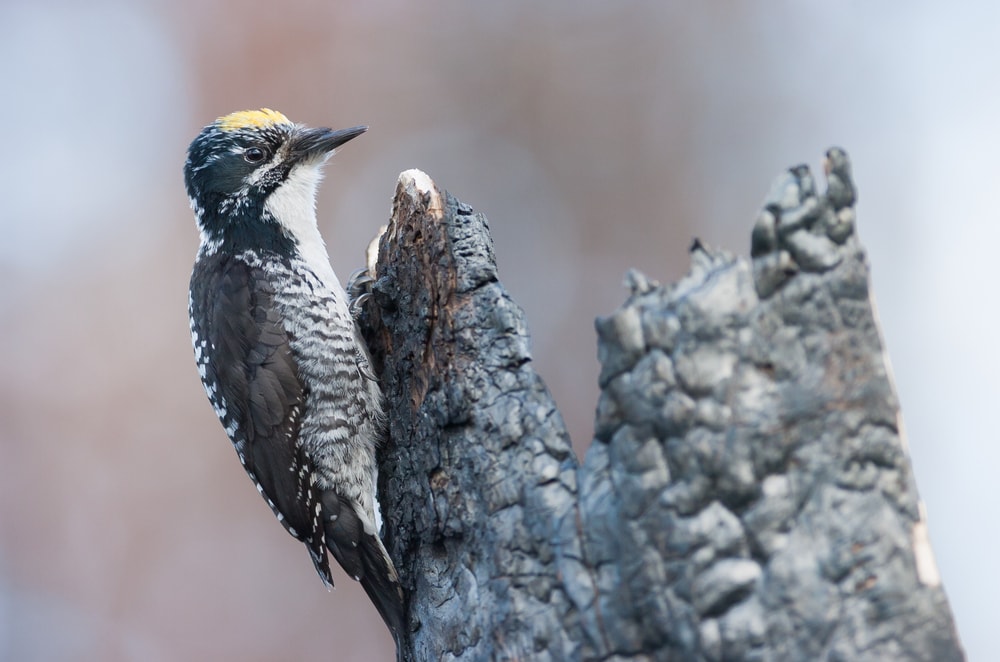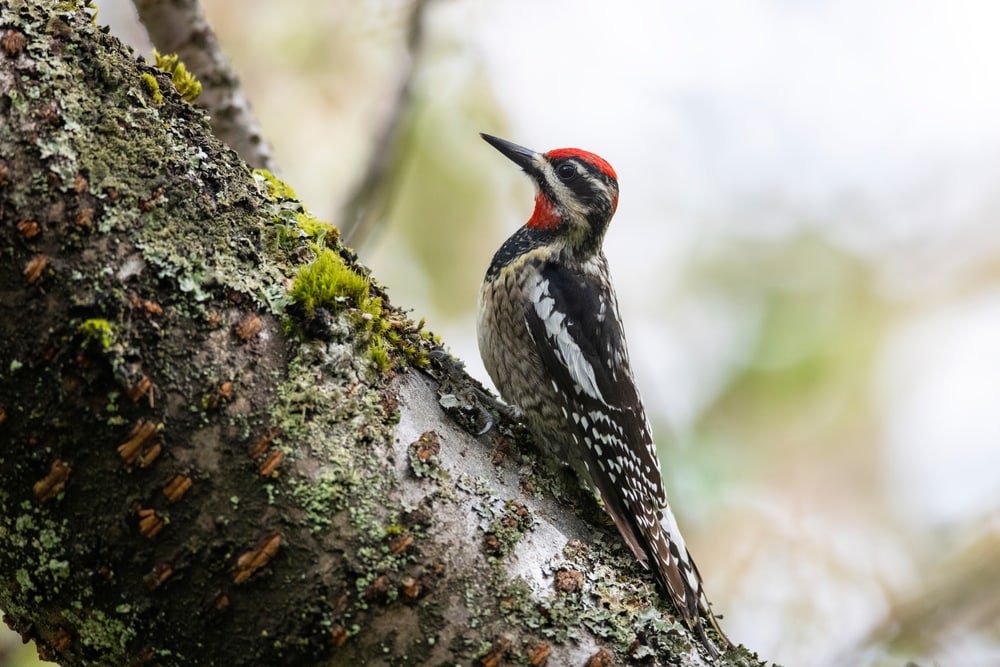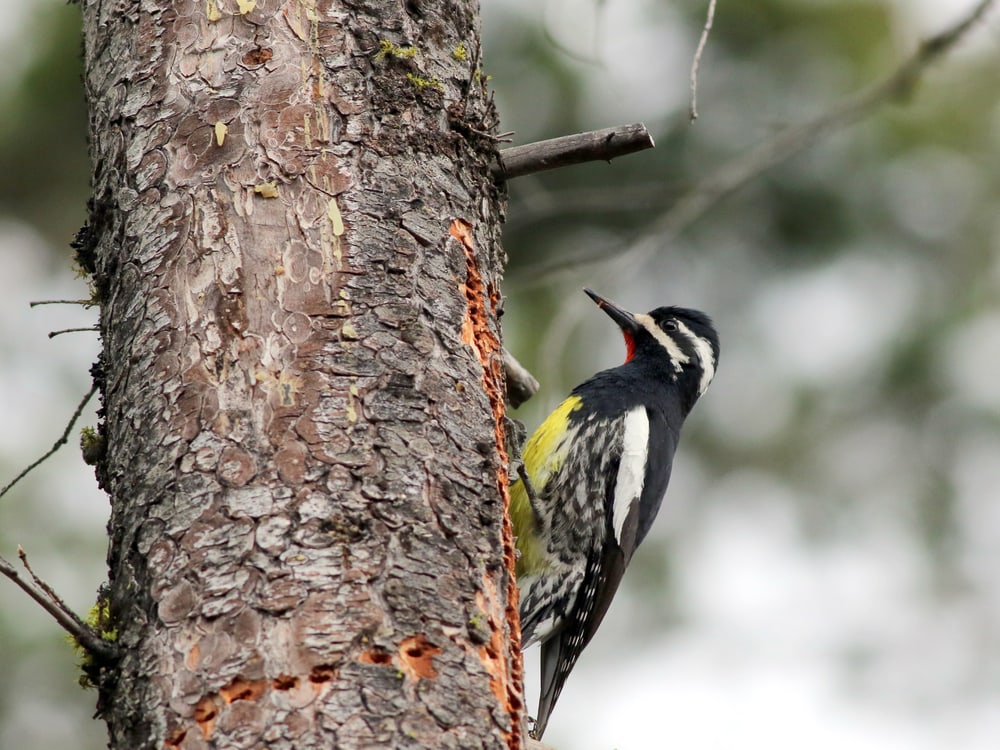
One of America’s birdwatching meccas, Arizona is home to over 550 species. Birdwatching is such a cool way to learn more about all of Arizona’s landscapes, and woodpeckers are one of the most entertaining species.
Curious to find out what woodpeckers you’ll see on your next hike? We’ll describe and identify all of them here.

SHARE THIS IMAGE ON YOUR SITE
<a href="https://outforia.com/woodpeckers-in-arizona/"><img style="width:100%;" src="https://outforia.com/wp-content/uploads/2022/12/Woodpeckers-in-Arizona-infographics.jpg"></a><br>Woodpeckers in Arizona <a href="https://outforia.com">Outforia</a>You May Also Like: Check Out This Guide To Birds of Colorado That You Should Know About with Photos, Infographic, Facts, and more!
1. Gila Woodpecker

The Gila is 8 to 9 inches (20.3 cm to 23.9 cm) in height, with a 16 inch (40.6 cm) wingspan. These woodpeckers weigh between 1.8 and 2.8 ounces (51 g and 79.4 g).
These birds are very active and easy to spot during the day. Listen for their rolling call that’s reminiscent of a Northern Flicker. If you investigate, you’ll likely flush them and get a good look.
Gila Woodpeckers are similar in appearance to both Flickers woodpeckers also found in Arizona. To the naked eye the Gila Woodpecker is smaller. Sharing the same brilliant checkerboard pattern on the wings with the Flickers, they lack any colored whisker coming off of their beak. Males will have a red crown on their head.
The Gila Woodpecker is found in the desert climates of central and southern Arizona. Look for them foraging the shrubs and cacti during the cooler parts of the day. Like most desert dwellers they’re less active during the heat of the day.
These expert cactus nesters are hugely admired by their desert-dwelling counterparts. Gila Woodpeckers drill nests months before breeding season and wait for the pulp to dry. After their nesting season ends, the cavities are left for other species to use. Owls and hawks will often use vacated nests in the Saguaro cacti they would otherwise be unable to build.
2. Gilded Flicker

The smaller flicker stands 11 inches (28 cm) tall, with a wingspan of 20 inches (50.8 cm). These woodpeckers typically weigh 3.3 to 4.5 ounces (93.6 g to 127.6 g).
Gilded Flickers are the color pattern hybrid of the Yellow-shafted and Red-shafted Northern Flicker. They differentiate most obviously from the Northern under the wings. Look for yellow patches under the wings and tail as opposed to red patches.
The Gilded Flicker lives in the scrublands of central and southern Arizona where it nests in the native Saguaro cacti. Here, it can forage the open land for ants and beetles.
When competing for a mate, the males will duel with their beaks. In a dramatic fencing match, they swing their beaks at each other while the females watch. The show never ends in an attack, instead the female will judge who is worthy of her affections.
The Gilded and Northern Flicker are great examples of Bergmann’s Rule. The species that occupy colder climates (Northern) will grow larger than their relatives in warmer ones (Gilded). The diet and temperament of the two are almost identical with the only difference being that Gilded Flickers are less likely to move in around our homes.
3. Northern Flicker

The Northern Flicker is 11 to 12 inches (29.4 cm to 30.5 cm) tall, with a 16 to 20 inch (40.6 cm to 50.8 cm) long wingspan. This Flicker will weigh between 4.5 and 5.5 ounces (113.4 g and 155.9 g).
You’re likely to only see the red-shafted species, defined by the red whisker off of their beak or color underneath their wings. Flickers can also be identified by their light brown coloring with a black-spotted chest.
One of few woodpeckers found in North America that is migratory. The Northern Flicker is found year-round in Arizona in woodlands north of the desert.
These birds are often seen in your backyard combing the forest floor and trees for insects. Bullies of the birdfeeder, their size and volume make it easy to scare off smaller visitors. If a group moves in, expect to be refilling your feeder sometime soon.
If you are ever wondering what is drumming on the side of your house, it’s likely the Northern Flicker looking for love. Opting for volume over display, the Northern Flicker is the only bird on the list that seeks out metal to ensure he is the loudest.
4. Hairy Woodpecker

A Hairy Woodpecker is 7.1 to 10.1 inches (18 cm to 25.7 cm) tall and has a 13 to 16 inch (33 cm to 40.6 cm) wingspan. Southern Hairy tend to weigh less, but the species typically 1.4 to 3.4 ounces (39.4 g to 96.4 g).
Look for the black wings checkered with white spots crawling up the trunks of a tree in your backyard. Hairy Woodpeckers will often visit feeders, giving you a good chance to see its bright red eye patch.
Note the size of its beak as well, as this is key in differentiating from the Downy. On a Hairy Woodpecker, the beak will be almost the same size as its head, assisting it in drilling for nests and insects.
In Arizona, you will find them in the northern part of the state’s forests hunting for insects. The Hairy Woodpecker looks like other desert dwellers on this list. Don’t be fooled, it won’t stray that far south to the desert.
The bird is very common, so finding it in populated suburban areas and city parks is possible. Any insect eater is a welcome backyard guest. Woodpeckers like the Hairy eat a lot of the insects we wouldn’t love having in our homes.
5. Downy Woodpecker

North America’s smallest woodpecker stands between 5.5 and 6.7 inches (14 and 17 cm) and has a 10 to 12 inch (25.4 to 30.5 cm) wingspan. A Downy only weighs between .7 and 1 ounce (19.8 and 28.3 grams).
It does not only look like its relative, the Hairy, it also behaves similarly. If you’re confused as to whether it’s a Downy or Hairy you’re looking at, pay attention to the size. If the woodpecker is noticeably smaller than a Robin, you’ve got a Downy.
Much like its doppelganger, the Hairy, the Downy Woodpecker has a huge range across all of the United States. In Arizona, it is primarily found year-round in the northern, forested parts of the state.
A Downy will not shy away from visiting a birdfeeder, and often will make its home in suburban backyards. Their sharp ‘pik’ call is easy to distinguish from the other backyard visitors.
These woodpeckers weigh so little they can feed on the weed stalks and reeds near a forest’s edge. Downys also have a noticeably smaller beak relative to the size of their head compared to most woodpeckers.
6. Acorn Woodpecker

These robin-sized woodpeckers stand 7.5 to 9.1 inches (19 cm to 23.1 cm), with a 14 to 17 inch (35.6 cm to 43.2 cm) wingspan. It weighs from 2.3 to 3.4 ounces (65.2 g to 90.7 g).
Male and female Acorn Woodpeckers have a striking red cap. There are two easy ways to ID this woodpecker. It has black circles around its eyes, contrasting the rest of its white face. In flight check for three white patches, one on each wing and another on the rump.
Eastern Arizona is the year-round home to the most social woodpecker on the list. They take up residence in the woodlands found in the area.
The woodpeckers will tend to store their impressive caches of acorns in oak forests. Despite the name, Acorn Woodpeckers will eat a variety of insects all year, and save the acorn supply for winter months.
The species’ social development enables them to effectively divide up work. Their work yields striking results for large groups of Acorn Woodpeckers, with some granary trees having thousands of storage cavities.
Different woodpeckers are responsible for drilling the holes in the tree, while others forage for acorns or provide a security detail. If you happen upon one of their trees, just listen for the parrot-like calls between group members.
7. Arizona Woodpecker

The Arizona Woodpecker stands between 7.1 and 7.9 inches (18 cm and 20.1 cm), with a wingspan of 14.2 inches (36.1 cm). This species is among the lightest, only weighing 1.2 to 1.8 ounces (34 g to 51 g).
Uniquely colored, it is perhaps the easiest to identify on this list. Brown and white, the Arizona Woodpecker has solid brown wings, a spotted chest, and a red crown
The breeding season is the time of year you are most likely to find the Arizona Woodpecker. Their loud ‘pik’ call is more likely to be heard during territorial disputes.
Despite the name, it is not common in Arizona. The Arizona Woodpecker mostly finds its home in the Sierra Madres of Mexico. They tend to be seen at elevations above 3000 feet in Arizona’s southeastern corner.
For this species, breeding season is all about who has the nicest place. During the late winter, males will begin nest construction. His hard work is rewarded when a potential mate approves his work. The female will go from nest to nest before weighing her options. After careful consideration, and a fluttering display from the male, she will choose her mate.
8. American Three-Toed Woodpecker

The American Three-toed Woodpecker is 8 to 9 inches (20.3 cm to 22.9 cm) tall, with a 15 inch (38.1 cm) wingspan. These birds will weigh 1.5 to 2.5 ounces (42.5 g to 70.9 g).
This medium-sized woodpecker is marked by the male’s yellow crown, and their drumming style is the clearest sign an American Three-toed is nearby. The rapid fire start will trail off, a drum unique to this woodpecker of Arizona.
A rare visitor to Arizona, the Three-toed Woodpecker can be seen in the White Mountain regions in the north of the state. Chances of spotting them will increase after a forest fire when they move in to comb the dead trees for insects.
Only three species of woodpeckers in the world share the three-toed evolution. The loss of the fourth toe in all is relatively unexplained. It’s thought the loss of the fourth toe allows the woodpecker to lean farther back for a harder strike.
Like many woodpeckers, the American Three-toed is a keystone species. Their nest building talent allows swallows and bluebirds to move in when vacated, which provides them with a safer nest.
9. Lewis’s Woodpecker

One of America’s most beautiful woodpeckers is 10 to 11 inches (25.4 cm to 27.9 cm) tall and has a 20 inch wingspan (50.8 cm). A Lewis’s Woodpecker weighs between 3 and 5 ounces (85 g and 141.8 g).
Despite their reputation, the Lewis’s look all black from behind. The color of their wings and back hides them while they move up a tree,
This camouflage makes them tough to identify while winding up a tree in search of food.
Wait until the sunlight for the beautiful color display. Lewis’s face and belly will shine bright red. If the light is right, the wings will also have an iridescent shine.
Similar to their coloring, the Lewis’s flight pattern is unique as well. They fly with large wingbeats and coast as compared to the typical bounding flight of a woodpecker.
The Lewis’s Woodpecker is active in a majority of Arizona depending on the time of year. During the breeding season, they make nests in the dead trees of the forests of the north. In the winter months, you will find them moving to lower elevations, closer to the desert.
Named after Merriweather Lewis of Lewis and Clark, the Lewis’s woodpecker is a bit of a misnomer. They rarely peck into trees, instead catching insects midair. When the flies disappear in winter, the Lewis’s will move south in search of nuts. Behaviors unbefitting of a woodpecker, these birds just don’t have the neck muscles to consistently drill for their food.
10. Ladder-Backed Woodpecker

These desert dwellers are 6.3 to 7.1 inches (16 cm to 18 cm) in height, with a 13 inch (33 cm) wingspan. Ladder-backed Woodpeckers are slight, and weigh only .7 to 1.7 ounces (19.8 g to 48.2 g).
The checkerboard pattern of their wings is like a Downy, but they inhabit very different areas. Ladder-backed are distinguished by the white rings on the back of the neck and the reddish crown of the males.
Often confused with the Nuttall’s Woodpecker, look for the red crown to be farther back on a Ladder-backed to differentiate the two. The female Ladder-backed has a black crown rather than red, and has a whiter face than the Nutall’s.
This desert woodpecker’s range is confined to the deserts of south and southeastern Arizona. Ladder-backed Woodpeckers are more likely to be seen in the very dry parts of the desert to avoid competition with the Nuttall’s of eastern California.
The Ladder-backed has a slight build, limiting its ability to peck into trees. But, this does allow it to chase insects in the small thorn forests of the desert better than other larger woodpeckers. If you struggle to find these evasive guys among the scrublands, listen for their distinct “peek” calls coming from the thorns.
11. Red-Naped Sapsucker

The smaller of Arizona’s sapsuckers stands between 7.5 and 8.3 inches (19.1 cm and 21.1 cm) and has a wingspan between 16.1 and 16.9 inches (40.9 cm and 42.9 cm). Red-naped Sapsuckers weigh 1.1 to 2.3 ounces (31.2 g to 65.2 g).
If you think you’re looking at one, males will have a red chin, crown, and throat. Females lack the red chin and instead have a white chin with a red collar.
Close in appearance to the Yellow-bellied Sapsucker, look carefully to tell the difference. Under the beak of the Red-naped will be a red patch on males, or a red collar on females. Yellow-bellied sapsuckers lack this subtle coloring difference.
The distinct drumming pattern is the key identifier of this species. They drum at a slower rate, making it sound more like a tap.
The Red-naped sapsucker is usually found hanging around the sweeter birch and aspen trees in the north of the state, but will sometimes navigate to the desert in search of Cottonwood trees in the nonbreeding season.
Their sweet tooth drives them to drill hundreds of tiny holes in trees in search of their reward. There are times a sapsucker will drill enough holes to kill the tree, making them an unpopular backyard resident.
Measures can be taken to keep these guys out of your yard. If Sapsuckers are drilling holes all over your backyard trees, wrap the affected area in burlap. This is the safest and least stressful way to deter them from hanging around.
12. Williamson’s Sapsucker

The Williamson’s Sapsucker stands between 8.3 and 9.8 inches (21.1 cm and 24.9 cm), with a wingspan between 16.1 and 16.9 inches (40.9 cm and 42.9 cm). They will weigh 1.6 to 1.9 ounces (45.4 g to 53.9 g).
The male and female Williamson’s look so different it took ornithologists until 1873 to determine they were the same species.
Males have a dark black crown and wings, with two white lines coming off of the beak and eyes. You can also identify them by their red throat and yellow belly. The female Williamson’s coloring is not so imaginative. Their head is a light brown, with white and black-barred wings.
Their call closely resembles the shriek of a hawk. The loud ‘chyaah’ is uncommon for a bird of its size, and useful in establishing territory.
Coniferous forests in the mountains of northern Arizona are home to this sapsucker during its breeding season. Throughout the winter months they migrate to the southern parts of the state, avoiding the desert.
The Williamson’s peck rings of shallow holes to suck out the sap. Their primary diet is made up of the insects stuck in the sap during the warmer months. Williamson’s Sapsuckers will save consuming the sap for the winter months.








